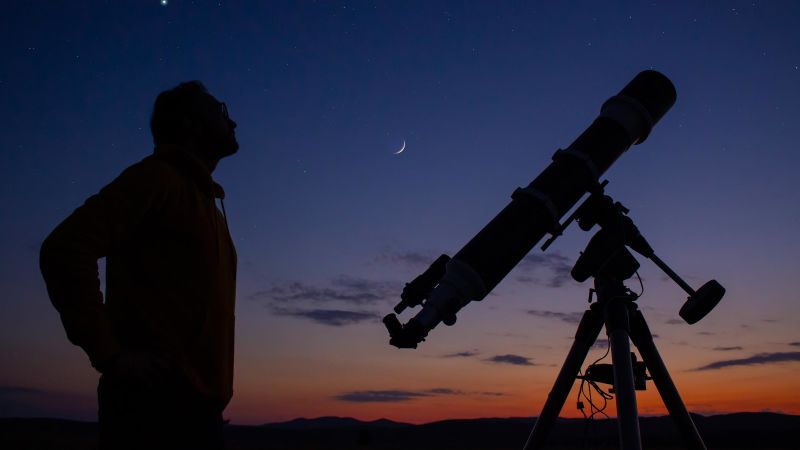
Subscribe to CNN’s Wonder Theory science newsletter. Journey through the universe with updates on captivating discoveries, scientific innovations, and more.
CNN
—
This February concludes with a celestial spectacle for stargazers: a lineup of seven planets will grace the night sky, including Mercury, Uranus, and Neptune alongside brighter planets like Mars, Venus, Jupiter, and Saturn. However, spotting all seven will pose a challenge, according to astronomers.
Although the seven planets will be positioned above the horizon shortly after sunset, Mercury and Saturn will be particularly tough to locate on Thursday and Friday evenings.
“Both Mercury and Saturn are situated close to the sun and may be obscured by its brightness. However, Mercury will ascend higher each day, making it easier to find,” explained Shannon Schmoll, director of the Abrams Planetarium at Michigan State University, in a statement.
“For the best chance of viewing, ensure you have an unobstructed view of the western horizon, and binoculars may enhance your sighting experience after sunset.”
On the other hand, Venus and Jupiter should be more straightforward to spot due to their luminosity, while Mars will be easily identifiable with its distinctive reddish-orange color, according to Schmoll.
It’s worth noting that Uranus and Neptune are typically not visible without optical aid, meaning a telescope or binoculars will likely be necessary for viewing, she added.
Curious about why so many planets are suddenly visible and how long this phenomenon will last? Here’s what you need to know.
Mercury and Saturn will appear as “horizon huggers,” likely only discernible during twilight or while the sky remains illuminated after sunset, with Venus being visible simultaneously, noted EarthSky editor Marcy Curran in a recent YouTube video.
“While Uranus and Neptune will be present, they require optical equipment to see clearly, and you’re unlikely to spot Jupiter and Mars until at least the onset of darkness,” she added.
Curran recommends searching for Mercury and Saturn about 30 minutes post-sunset, as they will be low on the western horizon and binoculars may enhance visibility.
“The planets will be positioned in the lower half of the sky,” explained Emily Elizondo, a doctoral student of physics and astrophysics at Michigan State, in a statement.
“Saturn and Mercury will be found toward the southwest, while Mars and Jupiter will be situated in the southeast. Neptune, Venus, and Uranus will be positioned in between. There are also mobile apps available that utilize motion-sensing technology to help you locate each planet by name in the sky.”
Unsure where to direct your gaze? If in doubt, look for Venus. This planet will shine brightly but will be located low in the western sky, steadily sinking closer to the horizon nightly until it vanishes by mid-March, explained EarthSky contributor John Goss. Venus is expected to resurface in the morning sky in April, according to NASA.
Unlike stars that flicker, Venus will emit a steady, bright glow in the sky.
As twilight draws to a close at 6:58 p.m. ET on Friday, the Cheshire moon will make its appearance, according to the space agency. This phase typically earns its name because the slender crescent resembles the smile of the Cheshire Cat from Lewis Carroll’s “Alice’s Adventures in Wonderland.” In Hawaiian culture, this phase is referred to as the wet moon, symbolizing a bowl capable of holding water, according to NASA.
The crescent moon will briefly rise just above the western horizon before setting approximately two minutes later. Meanwhile, Mercury will continue its ascent in the sky post-sunset in the coming days, positioned a few degrees above the moon, with Venus located above both, according to EarthSky.
Over the weekend, the crescent moon, Venus, and Mercury will appear in alignment, according to EarthSky.
“Let the bright light of Venus serve as your beacon. It will be the first to reveal itself as it shines higher in the sky,” said Curran. “Once you locate Venus, direct your gaze lower towards the horizon to spot the slender crescent moon and Mercury.”
Goss anticipates that Jupiter will remain visible high in the southern sky for the next couple of months, while Mars will be observable in the eastern sky for an additional three to four months.
Should cloudy skies or adverse weather hinder your view, the Virtual Telescope Project will provide a live stream from its robotic telescopes in Manciano, Italy, all set beneath pristine dark skies.

The visibility of the planets lining up in the night sky results from their aligned orbits around the sun.
“All the planets revolve around the sun in a flat disk,” explained Schmoll. “From our vantage point on Earth, that disk appears as a curved line spanning the sky, from east to west. Consequently, all the planets will always be visible along this trajectory, and when multiple planets align, it creates a stunning visual effect.”
Typically, the planets are distributed along the trajectory they orbit around the sun, known as the ecliptic, due to their individual movements. However, in February, these planets align on the same side of the sun relative to Earth, resulting in their simultaneous visibility in the night sky.
“This February is particularly remarkable because, instead of being widely spaced apart, the planets are all positioned along a segment of their orbital path, leading to their visibility at the same time,” noted Seth Jacobson, an assistant professor in the College of Natural Science’s Department of Earth and Environmental Sciences at Michigan State University.









